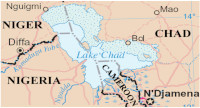The Impact Of Drought And Desertification In The Lake Chad Basin Region
Keywords:
Drought, desertification, Lake Chad, climatic trend, socioeconomic lifeAbstract
The main purpose of this study was to assess and analyze the climatic trends in the Lake Chad basin region between 1960 and 2002 for which the climatic data is made available. This is because of the impact of drought and desertification in the region which affects socio-economic life of the people in very remarkable ways as virtually every economic activity that the people engaged in is dependent on weather. The data for annual rainfall and temperature were for synoptic meteorological stations within the basin. These included N'Djamena, Mao, Bousso, SARH, Lai (Logone), Djimtilo (near Lake), Bol (Lake). The main findings revealed that the climatic data with respect to rainfall total annual figures show a declining trend until about the early 1980s, there after it begins to show an upward trend. The temperature patterns also varied from one stations to the other although Mao stands out from the other stations. The general trend from the polynomial curve is that of a slight decline from 1960 to 2002. It can be concluded that a proactive allocation of water among the various communities in the basin must be pursued to ensure that everyone has access to water optimally.
References
Adesina, F. A. (1993). Potentials of agro forestry for drought and desertification control in Nigeria Workshop Proceedings, National Workshop on drought, deforestation and desertification, Bayero University, Kano.
Bohel H. G., Downing T. E. and Watts M. C. (1994). Climate change and social Vulnerability: Toward a sociology and geography of food insecurity. Global Environmental Change, 4 (1), 37-48
Briasoulis, H. (2001). Analysis of landuse change: Theoretical and modeling approaches. Ph.D. Thesis (unpublished) Department of Geography, University of Aesgean Lessees, and Greece.pp.201-206.
Dami, A. (2008). Geographic Information System (GIS) based predictive study of environmental change in the Nigerian's section of the Chad Basin. Ph.D. thesis. Unplished. OAU IleIfe
IPCC (2007). Summary for Policymakers. In Climate Change 2007: Impacts, Adaptation and Vulnerability. Contribution of Working Group II to the Fourth Assessment Report of the Intergovernmental Panel on Climate Change, eds., M. L. Parry, O. F. Canziani, J. P. Palutikof, P. J. van der Linden and C. E. Hanson, Cambridge, UK: Cambridge University Press, p. 9).
LCBC (2007). Regional Roundtable on sustainable development of the Lake Chad Basin, University of Maiduguri, Nigeria.
Shiklomanov, I. (1993). A guide to the world's fresh water resources. http:// www.worldlakes.org/ whylakes.htm.http://www.evsc.virgnia.ed/desert
Thambyahphillay, G. G. R. (1987). Meteorological and Climatological Perspective of Drought and desertification in the Lake Chad Basin of Sahelo-Soudan Nigeria. Paper presented to the Chad Basin Commission's International Seminar on Water Resources in the Lake Chad Basin: Management and Conservation, N'Djamena (Republic of Chad) 3rd-5th June, 1987.
UNEP (2003). Draft Desk Study Version 1 'On Lake Chad basin'. Report Compiled by UNEP AEO, GIWA, UNEP DEPI Michael T. Coe, and Jonathan A. Foley and Lake Chad Basin Commission. Department of Early Warning and Assessment (DEWA), UNEP, Nairobi, Kenya.

